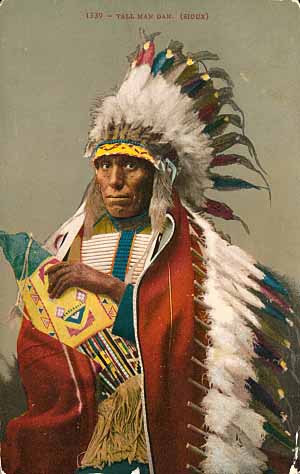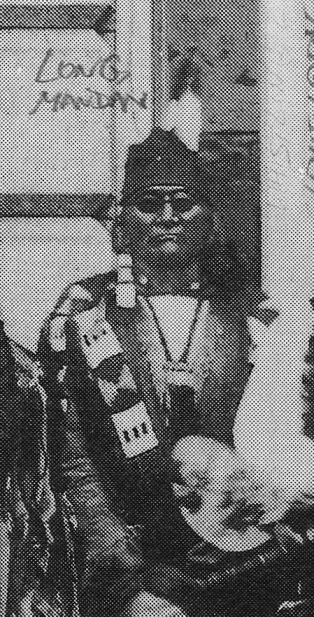Post by Dietmar on Dec 8, 2010 10:57:33 GMT -5
Gregor has written another essay, this time about Two Kettle leader Tall Mandan, who was also known in many historical records as Long Mandan:
Tall Mandan
Miwatani Hanska
(abt. 1804 - ?)

Tall/Long Mandan or Miwatani Hanska was a chief of the Oohenompa Lakota (Two Kettles). According to a New York Times article dated June 7, 1875, Long Mandan must have been born about 1804/1805. Originally a Sihasapa (Blackfeet) Lakota, he married into the Two Kettles, where he evolved to a respected leader.
According to Joseph Nicollet, the Oohenompa Lakota (Two Kettles) evolved about 1839 from the Mnikowozu or a Saone tribe. Stephen R. Riggs, visiting Fort Pierre about 1840 from Minnesota, noted "The Oohenonpa or Shunkayutexni" (Eat No Dogs) at 100 lodges, who “commonly range north of the Blackfeet Sioux." Thaddeus A. Culbertson rated the Two Kettles in 1850 at 60 lodges under chief Four Bears.
(See Kingsley M. Bray, “Teton Sioux: Population History, 1655-1881,” Nebraska History 75/1994, p. 165-188.)
In the late 19th century, several tiyospaye are reported for the Two Kettle tribe, including the following noted by Josephine Waggoner, where she rated the Long Mandan family as of the Eat No Dogs band:
Tiyospaye chiefs & headmen
1. Wanuwaktenula (Killed Accidentally) Swift Bird
2. Sunka-yutesni (Eat No Dogs) Long Mandan I
3. Minisa-la (Red Water Black) Spotted Horse
4. Oiglapta (Take All That Is Left) Four Bears II
Little is known about this leader. Long Mandan/Tall Mandan signed both Fort Laramie Treaties in 1851 and 1868 and in 1856 the agreement with General Harney at Fort Pierre. He signed the 1856 agreement on March 5th in the first place as “The Long Mandan, principle chief of the “two Kettles”. According to Kappler’s Indian Affairs: Laws and Treaties, there are two signatures of a Long Mandan (Miwatani Hanska) on the 1868 treaty. One person signed on April 29, 1868, with the Brulé. Another Long Mandan signed with the Two Kettles – along with the Hunkpapa – on July 2, 1868, at Fort Rice. In all likelihood these are two different persons. The man who signed with the Brulé (photographed by Gardner) is reported to be an akicita of the corn band. This Brulé also signed the agreement of September 23, 1876 – the relinquishment of the so called un-ceded territories – at the Spotted Tail agency.
In 1867, Long Mandan was part of a Sioux delegation that visited Washington. With regard to Long Mandan, little is known about this journey. The sole evidence of his participation is a photograph by Zeno Shindler, which must have been taken between February 17 and April 8, 1867, at Shindler’s studio.
In June 1875, Long Mandan visited Washington and New York again as part of the “Black Hills” Sioux delegation. The New York Times reported on June 7, 1875:
“The Indian chiefs, under the leadership of Lone Horn and Long Mandan, arrived in Jersey City yesterday morning on the 6:20 train from Washington. They were accompanied by Major H.W. Bingham of the Cheyenne River Agency. ….Long Mandan, [his?] the father of the Minneconjons [sic], …is nearly seventy years of age. He has been very much impressed by his Eastern trip, and says the strength and riches of the white men have literally overwhelmed him”.
The New York Times further mentioned Major Saville (Indian Agent), William Fielder (interpreter), Lone Horn (Mnikowozu), Long Mandan (Oohenumpa), and Charger (Sans Arc). The others (White Swan, Rattling Ribs, Spotted Elk, Bull Eagle, Red Skirt, and Duck) were “sub-chiefs.”
The minutes of the 1875 talks with the U.S. government report the following quote of Miwatani Hanska (Long Mandan):
“My friends, when I went to Washington [1867] I went into your money-house and I had some young men with me, but none of them took any money out of that house while I was with them. At the same time, when your Great Father's people come into my country, they go into my money-house [the Black Hills] and take money out.”
Beside his political activities, there is little known of Long Mandan’s private life, except for an alleged quarrel with the hotspur Gall of the Hunkpapa.
“It happened that a Sioux named Long Mandan went up to the Ree village at Fort Berthold, and took a Ree wife. Gall thought this a disgrace — a kind of treason — for a Sioux and a head man to go and live with the Rees. Gall went up there and ran off some of Long Mandan’s horses”
(Stanley Vestal, New Sources. of Indian History, 1850-1891, p. 221 f.)
Robert W. Larson gives another version of this incident – which happened in 1865 – in his book Gall: Lakota War Chief. According to him, the Ree-Hunkpapa scout Bloody Knife was the catalyst for this occurrence.
(Robert W. Larson, Gall: Lakota War Chief, pp. 56, 248)
Long Mandan (or Bloody Knife) went to Fort Stevenson and reported the incident. As a consequence of this, the military tried to bust Gall in the vicinity of Fort Berthold. In a brawl Gall was seriously injured.
Long Mandan’s date of death and his burial place are not known.
Compiled by Gregor
Thank you Gregor!
Please add what else is known about Long Mandan.


Long Mandan, 1867

Portrait of Peter Tall Mandan, Grandson of Long Mandan, 1905 by De Lancey W. Gill
(all images linked from SIRIS, Smithsonian Institute)
Tall Mandan
Miwatani Hanska
(abt. 1804 - ?)

Tall/Long Mandan or Miwatani Hanska was a chief of the Oohenompa Lakota (Two Kettles). According to a New York Times article dated June 7, 1875, Long Mandan must have been born about 1804/1805. Originally a Sihasapa (Blackfeet) Lakota, he married into the Two Kettles, where he evolved to a respected leader.
According to Joseph Nicollet, the Oohenompa Lakota (Two Kettles) evolved about 1839 from the Mnikowozu or a Saone tribe. Stephen R. Riggs, visiting Fort Pierre about 1840 from Minnesota, noted "The Oohenonpa or Shunkayutexni" (Eat No Dogs) at 100 lodges, who “commonly range north of the Blackfeet Sioux." Thaddeus A. Culbertson rated the Two Kettles in 1850 at 60 lodges under chief Four Bears.
(See Kingsley M. Bray, “Teton Sioux: Population History, 1655-1881,” Nebraska History 75/1994, p. 165-188.)
In the late 19th century, several tiyospaye are reported for the Two Kettle tribe, including the following noted by Josephine Waggoner, where she rated the Long Mandan family as of the Eat No Dogs band:
Tiyospaye chiefs & headmen
1. Wanuwaktenula (Killed Accidentally) Swift Bird
2. Sunka-yutesni (Eat No Dogs) Long Mandan I
3. Minisa-la (Red Water Black) Spotted Horse
4. Oiglapta (Take All That Is Left) Four Bears II
Little is known about this leader. Long Mandan/Tall Mandan signed both Fort Laramie Treaties in 1851 and 1868 and in 1856 the agreement with General Harney at Fort Pierre. He signed the 1856 agreement on March 5th in the first place as “The Long Mandan, principle chief of the “two Kettles”. According to Kappler’s Indian Affairs: Laws and Treaties, there are two signatures of a Long Mandan (Miwatani Hanska) on the 1868 treaty. One person signed on April 29, 1868, with the Brulé. Another Long Mandan signed with the Two Kettles – along with the Hunkpapa – on July 2, 1868, at Fort Rice. In all likelihood these are two different persons. The man who signed with the Brulé (photographed by Gardner) is reported to be an akicita of the corn band. This Brulé also signed the agreement of September 23, 1876 – the relinquishment of the so called un-ceded territories – at the Spotted Tail agency.
In 1867, Long Mandan was part of a Sioux delegation that visited Washington. With regard to Long Mandan, little is known about this journey. The sole evidence of his participation is a photograph by Zeno Shindler, which must have been taken between February 17 and April 8, 1867, at Shindler’s studio.
In June 1875, Long Mandan visited Washington and New York again as part of the “Black Hills” Sioux delegation. The New York Times reported on June 7, 1875:
“The Indian chiefs, under the leadership of Lone Horn and Long Mandan, arrived in Jersey City yesterday morning on the 6:20 train from Washington. They were accompanied by Major H.W. Bingham of the Cheyenne River Agency. ….Long Mandan, [his?] the father of the Minneconjons [sic], …is nearly seventy years of age. He has been very much impressed by his Eastern trip, and says the strength and riches of the white men have literally overwhelmed him”.
The New York Times further mentioned Major Saville (Indian Agent), William Fielder (interpreter), Lone Horn (Mnikowozu), Long Mandan (Oohenumpa), and Charger (Sans Arc). The others (White Swan, Rattling Ribs, Spotted Elk, Bull Eagle, Red Skirt, and Duck) were “sub-chiefs.”
The minutes of the 1875 talks with the U.S. government report the following quote of Miwatani Hanska (Long Mandan):
“My friends, when I went to Washington [1867] I went into your money-house and I had some young men with me, but none of them took any money out of that house while I was with them. At the same time, when your Great Father's people come into my country, they go into my money-house [the Black Hills] and take money out.”
Beside his political activities, there is little known of Long Mandan’s private life, except for an alleged quarrel with the hotspur Gall of the Hunkpapa.
“It happened that a Sioux named Long Mandan went up to the Ree village at Fort Berthold, and took a Ree wife. Gall thought this a disgrace — a kind of treason — for a Sioux and a head man to go and live with the Rees. Gall went up there and ran off some of Long Mandan’s horses”
(Stanley Vestal, New Sources. of Indian History, 1850-1891, p. 221 f.)
Robert W. Larson gives another version of this incident – which happened in 1865 – in his book Gall: Lakota War Chief. According to him, the Ree-Hunkpapa scout Bloody Knife was the catalyst for this occurrence.
(Robert W. Larson, Gall: Lakota War Chief, pp. 56, 248)
Long Mandan (or Bloody Knife) went to Fort Stevenson and reported the incident. As a consequence of this, the military tried to bust Gall in the vicinity of Fort Berthold. In a brawl Gall was seriously injured.
Long Mandan’s date of death and his burial place are not known.
Compiled by Gregor
Thank you Gregor!
Please add what else is known about Long Mandan.


Long Mandan, 1867

Portrait of Peter Tall Mandan, Grandson of Long Mandan, 1905 by De Lancey W. Gill
(all images linked from SIRIS, Smithsonian Institute)






